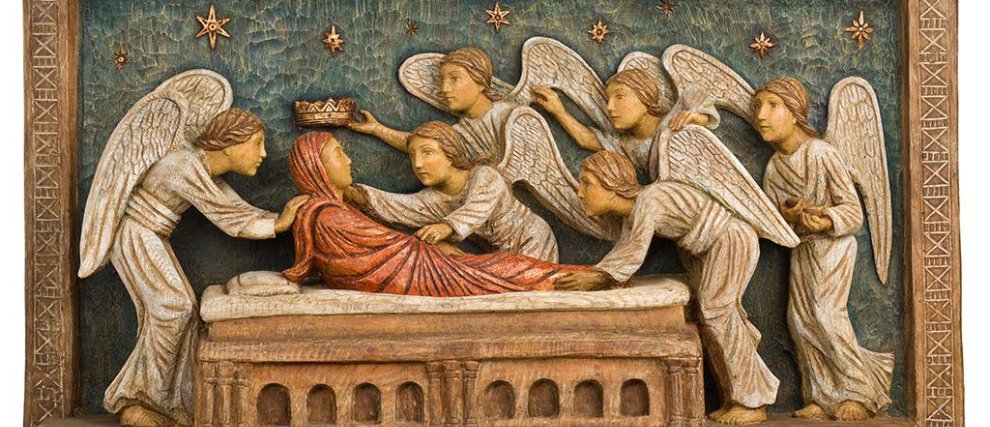Feast of the Assumption: Meaning, Celebration, Prayers
August 15 is a public holiday in many countries, because on this date, Catholics celebrate the Assumption of the Blessed Virgin Mary, also called the Dormition of Mary in the Eastern tradition. Initially celebrated by Eastern Christians since the sixth century, this great Marian feast was instituted a century later in the West by Pope Sergius I. The Assumption was also proclaimed as a dogma of faith by Pope Pius XII in 1950.
Discover what meaning the Catholic Church gives to the feast of the Assumption and how Christians glorify the Virgin Mary on the occasion of August 15!
What is celebrated during the feast of the Assumption?
The Assumption of the Virgin Mary
Celebrated on August 15, the Marian feast of the Assumption—also called “Dormition of Mary” among the Orthodox - celebrates the elevation by God of the soul and body of the Virgin Mary.
Etymologically, the term “assumption” comes from the Latin “assumere” which translates as “to remove”. This means that at the end of her earthly life, the Blessed Virgin was “taken up by God” to enter into heavenly glory.
Thus, on the day of the Assumption, Christians glorify Mary via her ascent to heaven, but also her coronation as queen. Indeed, Catholic liturgy closes the feast of the Assumption with the celebration of the feast of Mary Queen of Heaven, eight days later, thus meaning that Mary is Queen and Sovereign “not only because of her divine motherhood, but also because according to the will of God, she played a part in the work of our eternal salvation”. (Encyclical letter of Pope Pius XII).
The Assumption: a feast, then a dogma.
The celebration of the Assumption of Mary dates back to the eastern traditions of the sixth century: the consecration of a church in Gethsemane in honor of the Virgin Mary—where she would have ended her earthly life—is probably at the origin of the date of August 15. Following this, the Marian feast took the name of “Dormition of Mary” and spread throughout the East under the reign of the Byzantine emperor Maurice.
In the West, the feast took the name of Assumption when it was instituted by the Church of Rome at the end of the 7th century, probably by Pope Sergius I. A real fervor for Mary developed under the reign of Louis XIII, when he placed France under the protection of Our Lady of the Assumption, in thanksgiving for the birth of his son. From then on, Marian processions developed throughout the country on the occasion of August 15.
In 1950, Pope Pius XII proclaimed the dogma of the Assumption: “The immaculate Virgin, preserved by God from any attack of the original fault, having completed the course of her earthly life, was lifted up body and soul to the glory of heaven, and exalted by the Lord as the Queen of the universe, to be thus more fully conformed to her Son, Lord of lords, victorious over sin and death.”
What is the difference between the Assumption and the Ascension?
Although the two terms “assumption” and “ascension” are similar and both denote an elevation to heaven, they nevertheless have distinct meanings:
Ascension refers to Jesus’ ascension to heaven after his death and resurrection. With this event, the mystery of Easter ends: Jesus, having humbled himself to death, then rose in glory!
The Assumption refers to the elevation of Mary to Heaven, body and soul, without her having to wait for the resurrection of the dead. Through his mother, Jesus attests to his victory over death and sin and announces our own resurrection.
The Celebration of Assumption by Christians
Liturgy, Marian processions, and festivities of August 15
As one of the biggest Marian feasts, the Assumption of the Virgin Mary is an opportunity for Christians to participate in beautiful ceremonies accompanied by processions, and to organize festivities of all kinds: great pardons, blessings of the mother, vigils, songs and prayers to the Virgin, etc. Each year, many pilgrimages also take place in the Marian shrines: Lourdes, Pontmain, La Salette, etc.
During celebrations or processions, a prayer for France is often recited. This is a tradition that stems from the consecration of France to Our Lady of the Assumption by Louis XIII.
The liturgy of August 15—orations, hymns, antiphons—are specific to the Solemnity of the Assumption. The readings emphasize the role of Mary in the history of salvation, as Mother of Christ: “Full of grace, rejoice! The Emmanuel has found a place in your illuminated home. Through you, glory has shone for the salvation of our race.” (Hymn of the Office of Vespers).
Marian worship related to the Assumption
The contemplation of the Virgin Mary through her Assumption is a pledge of hope for Christians: Mary, lifted up body and soul in divine glory, sets out the destiny of humanity, because we are all called to follow her path of resurrection.
It is for this reason that Mary is called “the first on the road”: by her Assumption, the victory against death and sin is already accomplished! To contemplate the Blessed Virgin is to discover the purpose of our earthly pilgrimage and to be guided by her throughout our lives, for us who still have to walk here below.
Raymond Bouchex explains this well when he says: “To celebrate the Assumption of Mary is to hear her tell us again what we are made for. Mary taken to heaven is with us. By being glorified with Christ, she did not distance herself from us, she became close to us immensely.”
The Prayer of the Assumption of the Holy Virgin
“O Jesus! Who made all the Greatness of Mary, who are now making Her happiness, give her to us as Mother, make us worthily celebrate her triumph, grant us through her intercession the virtues that made her become your Mother, open for us the treasures of heaven, make us receive you with the same dispositions in the Holy Eucharist, that the Most Pure Virgin received you in her womb, make us live the Life she lived, and that we die like her in Charity, so that we can live like her in Glory. O Mary! O our Most Merciful Mother! Be our Advocate to the Most Holy Trinity, look down from heaven on our struggles, make us win the victory, obtain for us the Graces we need to avoid sin, to detach ourselves from the affection of the world, and to sigh only after the happy Eternity.”
Gaspard-Jean-André-Joseph Jauffret (1759-1823)
Praying to Mary with Hozana
Mary, “the first on the road,” precedes us in the glory of the resurrection and anticipates the time of salvation promised to the children of God. You can follow his path of faith and hope with the prayers that Hozana offers you:
Pray to Mary, Mother of Christ, to
by praying to her on the occasion of the great Marian feasts. as we pray this novena in honor of Our Blessed Mother under the title of the Queenship of the Blessed Virgin Mary., under the guidance of the devoted Marian Apostle, St. Maximilian Kolbe.
